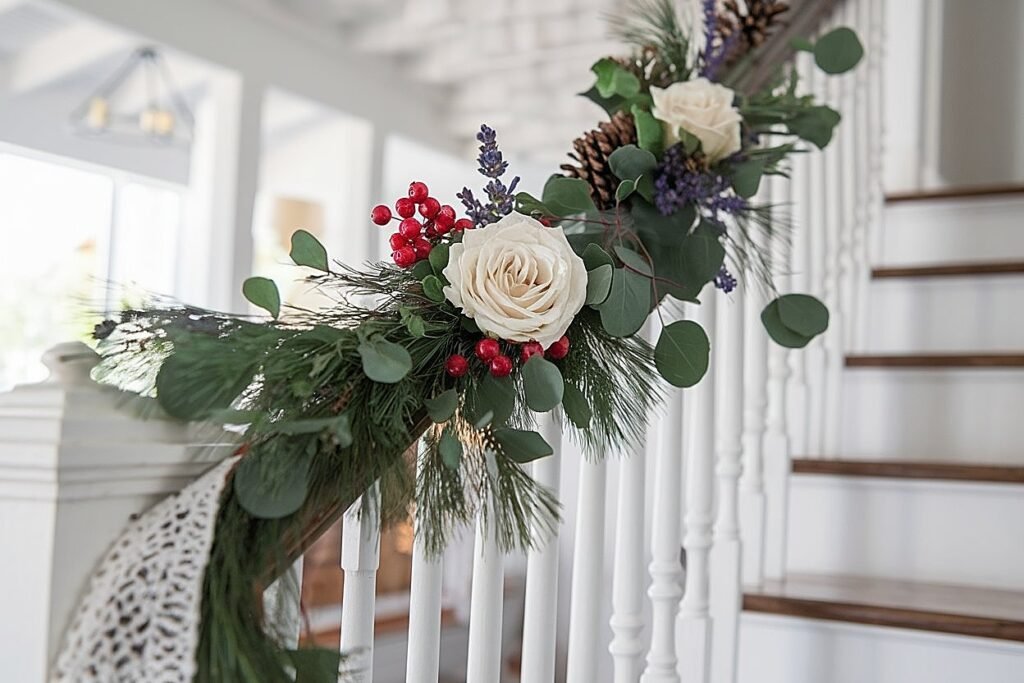
This website contains affiliate links, and some products are gifted by the brand to test. As an Amazon Associate, I earn from qualified purchases. Some of the content on this website was researched and created with the assistance of AI technology.
Key Takeaways:
- Build a strong evergreen spine (noble fir + cedar) before adding roses and lavender; wire everything short for clean lines and longevity.
- Drape in intentional swags that respect your stair rhythm: anchor at newel posts, breathe between balusters, and thicken at turns and landings.
- Keep scent and structure balanced—lavender for cool, airy line; roses for focal weight—then finish with restrained lights, ribbon, and rustic accents.
How to Style Lavender-Rose Staircase Garlands for Christmas starts with one simple truth: stairs are a runway. People touch the rail, kids fly by, guests pause at the landing—so your garland must be beautiful, durable, and safe. Lavender brings that calming, winter-cool note; roses deliver the romantic punch. Together, they read designer without veering into fussy.
I’ve installed garlands in creaky farmhouses and crisp new builds, and the winning approach never changes: structure first, fragrance second, ornament last. If you wire cleanly, keep stems short, and scale the swags to your railing, your staircase becomes the home’s holiday heartbeat.
| 🌸 Styling Option | 🪟 Placement Ideas | ✨ Accent Details | 🏡 Farmhouse Pairing |
|---|---|---|---|
| Lavender-Rose Stair Rail Garlands | Banisters, rails, landings | Fairy lights, burlap bows, pinecones | Rustic benches & frosted farmhouse windows |
| Rustic Newel Post Florals | Base posts, landing posts | Mini wreaths, lace ribbons, roses | Wooden sideboards & vintage sled props |
| Lantern Step Styling | Every second stair step | Candles in mason jars, lavender sprigs | Plaid runners & farmhouse baskets |
| Hanging Garland Accents | Windows, landings, stairwell beams | Dried oranges, cinnamon sticks, fairy lights | Rustic lantern hooks & plaid throws |
| Seasonal Accent Layers | Garland edges, stair corners | Berries, ornaments, cedar greenery | Vintage rocking chairs & galvanized tins |
How to Drape Lavender-Rose Christmas Garlands Along Stair Rails
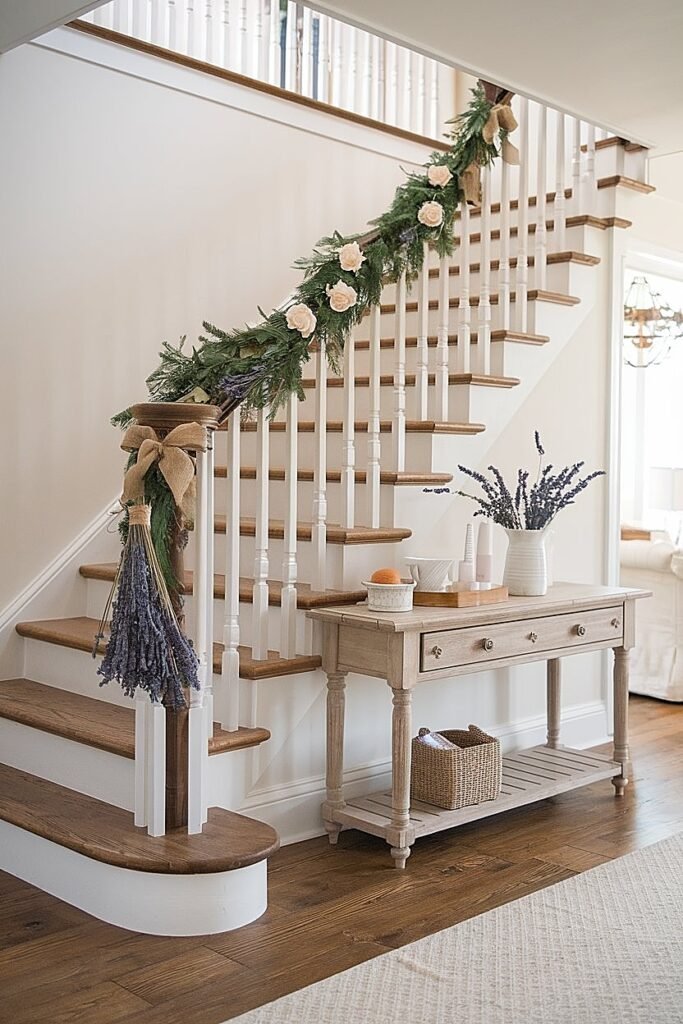
Staircases have a built-in tempo—post, baluster, post—that you can either fight or conduct. I map the run with painter’s tape first, marking anchor points at the newel, each turn, and every second or third baluster depending on span. That gives me predictable drape without sagging surprises.
I build a base from noble fir (for backbone) layered with cedar (for soft fall). Cable ties or floral wire secure the greens; then I weave battery micro-LEDs into the spine before any blooms touch the rail. Roses (short-wired heads) go in as tight clusters near anchors. Lavender threads last, arcing like cursive to connect clusters and carry scent.
Anchor the garland at the newel and each turn, swag between every 18–24 inches, cluster roses at anchors, and “stitch” lavender through the negative space. For outdoor continuity and rustic charm that echoes this palette at your entry, see Rustic Christmas Porch Styling with Roses and Lavender—and if this helps, share it with friends who love a good staircase moment. There’s more below on floral supporting cast—keep reading.
What Are the Best Florals to Mix with Christmas Lavender-Rose Garlands?

Your staircase needs filler that holds form, dries gracefully, and won’t shower the treads. I mix fresh and dried for durability and texture contrast, keeping scale disciplined so the rail still functions.
I aim for three roles in the mix: structure, softness, and curiosity. Structure frames, softness blurs, curiosity makes guests lean in.
- Seeded Eucalyptus: Sage-green disks and dotted pods add movement without bulk. It bridges lavender’s cool tone to most rose palettes and reads festive even with minimal ornaments. Hydrate well, then use short wired clusters for tidy placement.
- Dusty Miller: Velvety silver leaves cool the composition and cushion rose clusters. It’s a visual exhale between color notes. Use sparingly in small pads beneath focal blooms to hide mechanics and soften edges.
- Juniper with Berries: Needle-fine texture plus dusty blue berries that echo lavender. It dries handsomely and acts like built-in ornaments. Tuck small tufts near light pockets for subtle sparkle.
- Olive Branch: Leathery leaves with silvery undersides that mirror lavender’s cast. Olive adds plush “farmhouse” credibility and photographs beautifully under warm LEDs.
- Boxwood: Tight, glossy leaves fill gaps and polish the line. Ideal along the top edge to hide wire ties and keep silhouettes crisp on minimalist rails.
- Ghost Fern (or Autumn Bracken): Feathery fronds create airy halos around clusters. Choose bronze-tinged varieties for a winter-meadow feel without adding heavy color.
- Silver Brunia: Round, pewter-toned buttons provide sculptural punctuation near roses. They’re durable, modern, and read like micro-ornaments.
- Hypericum (White or Blush): Small berries add holiday nods without going “holly.” Keep stems short and clustered for neatness on busy stairs.
- Baby’s Breath (Dried): In tiny doses, it’s a snow-dust veil. Mist lightly before wiring to reduce shedding and tuck deep to soften transitions.
Pick one structural green, one silver-cool softener, and one textural accent per 18–24 inches to avoid visual noise. More seasonal add-ins next—keep reading to layer story without clutter.
How to Add Seasonal Accents to Lavender-Rose Christmas Garlands
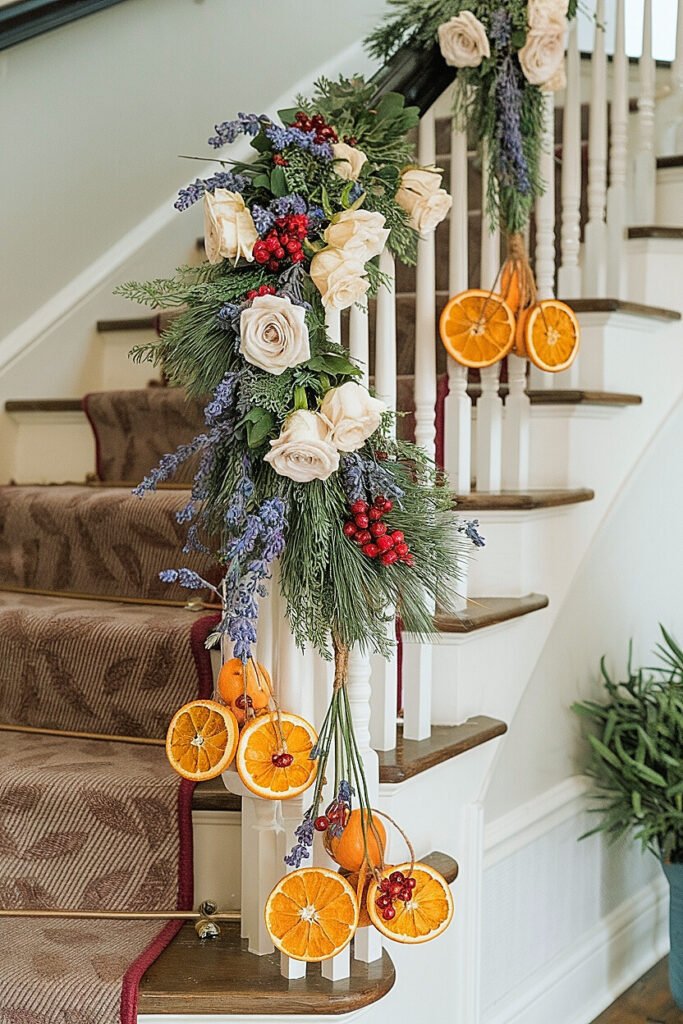
Accents should whisper the holiday, not drown the florals. I curate a small set of repeating elements that tie rooms together—think a single metallic, a natural material, and one nostalgic touch.
Placement matters. I cluster accents near turns, newels, and the center of each swag so the eye lands where the structure is strongest.
I favor: frosted pinecones (wired in pairs), dried orange wheels (thin, matte), and velvet micro-tails woven near rose clusters. Clear acrylic “ice” picks sunk deep in greens create prismatic glow without visible plastic.
Choose three accents max, repeat them rhythmically, and keep them tight to anchors for tidiness. More ribbon strategy is coming—keep reading to select bows that actually hold.
What Are the Best Bows and Ribbons for Rustic Christmas Stair Garlands?
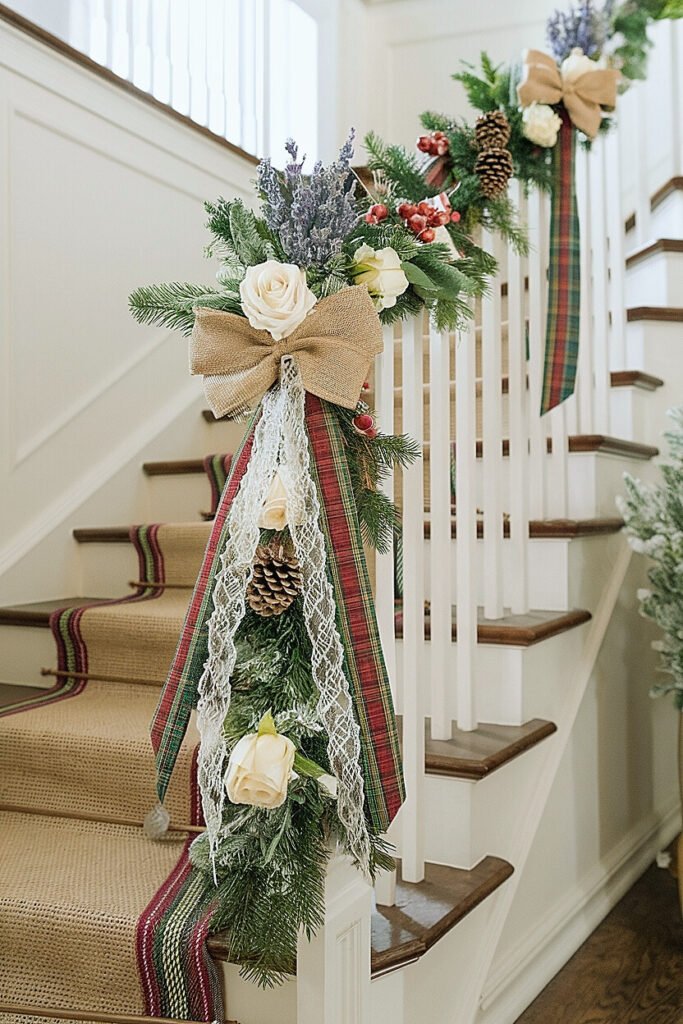
Ribbon sets mood and controls the line. I avoid one long run; instead, I use short “tuck and loop” pieces for consistency and easy fixes. Mix textures—one plush, one sheer, one micro metallic—for depth under evening light.
Scale bows to architecture: larger near the newel, smaller on intermediate posts, micro loops within swags. Always wire through the spine, not a twig.
- Velvet (2–2.5 in): Plush, light-absorbing, and sculptural. Velvet anchors focal points at newels and turns, hides mechanics, and adds instant luxury to rustic greens and roses.
- Silk Taffeta (1.5 in): Holds crisp loops that won’t flop on high-traffic rails. Great for figure-eight tucks along swags; the subtle sheen plays nicely with dusty miller and olive.
- Linen Tape (1 in): Matte, tactile, and reusable. Linen bridges farmhouse textures—crates, benches—to the garland. Use as supportive bands for micro-bundles.
- Organza (1.5 in sheer): Airy lighten-up that lets greens show through. I layer organza under velvet to keep heavy sections buoyant and visually soft.
- Metallic Micro-Cord (¼ in): A jewelry note—wrap lavender stems, tie tiny knots at cluster bases, and echo your chosen metal (pewter, champagne, bronze).
At each anchor use velvet + one secondary + micro-cord; inside swags use only secondary + micro-cord for restraint. More palette guidance up next—keep reading to lock your color story.
What Are the Best Color Palettes for Christmas Staircase Garlands?

Light temperature, wall paint, and banister finish decide how colors behave. I always test under actual bulbs at night before committing.
Pick one base temperature, one floral hue, and a metal that harmonizes. Then repeat with discipline.
- Icy Blush + Lavender + Silver: Blush garden roses, lavender sprigs, and silver accents. Cool, airy, editorial. Juniper and eucalyptus reinforce the palette.
- Cream + Dusty Pink + Champagne: Cream roses with dusty miller and champagne ribbon. Warm but refined; ideal against dark wood rails.
- Mulled Wine + Mauve + Bronze: Claret focal roses, mauve sprays, and bronze touches. Cedar movement keeps it from feeling heavy; lavender lifts the mood.
- Bone + Sage + Lavender-Grey: Minimalist calm—boxwood and olive with lavender, bone tapers nearby. Chrome-free, matte-forward.
- Dusty Rose + Pewter + Soft Plum: Antique vibes that love pewter bells and Brunia. Works with collected interiors and vintage frames on the stair wall.
- Snow White + Heather + Smoke: White roses, heather-laced lavender, smoky glass ornaments. Keep LEDs warm to avoid clinical chill.
- Ivory + Soft Gold + French Lavender: A classic holiday read with gentle glow. Gold micro-cord and organza add dusk-friendly warmth.
Choose your trio, then echo it every 18–24 inches and at every turn. More spatial styling next—keep reading to integrate nearby furniture authentically.
How to Add Farmhouse Furniture Near Christmas Staircase Garlands
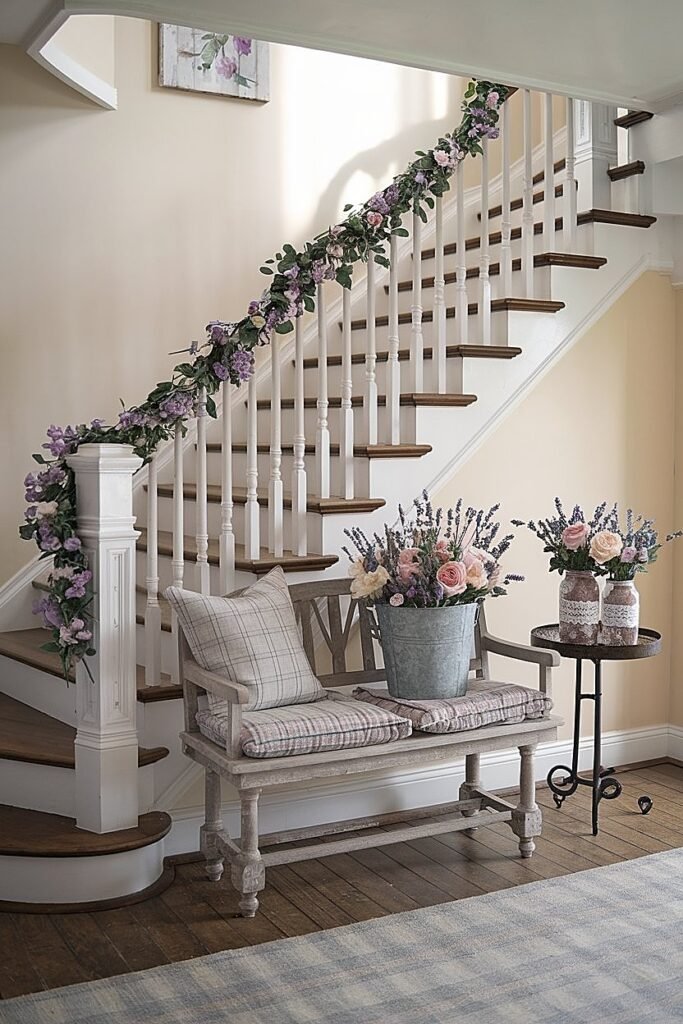
The area under and beside stairs is staging real estate. I use a narrow console, a vintage crate stack, or a small bench to ground the garland and provide safe distance from foot traffic.
Textures matter. Weathered wood, wicker, and matte metals echo rustic notes from the greens while giving you surfaces for low florals and lanterns.
Set a shallow tray with mercury votives, a wicker basket with lavender bundles, and one stoneware crock of roses at knee height. Keep paths clear; nothing should jut beyond the tread line.
Place one functional piece (console/bench) within sight of the newel, repeat your palette in micro-arrangements, and keep depth shallow. More design balance ahead—keep reading to blend minimal and rustic without muddle.
Ways to Balance Minimalism and Rustic Charm in Christmas Garlands
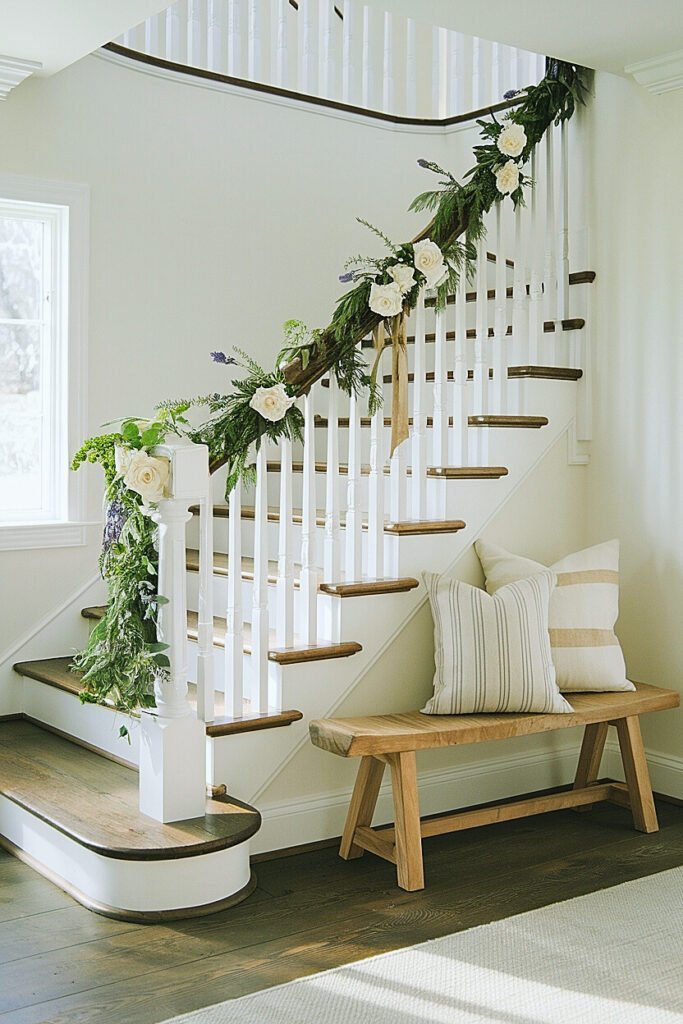
Minimal doesn’t mean empty; rustic doesn’t mean messy. You’re aiming for edited warmth. I choose an architectural base and limit flourishes to predictable beats.
I use negative space as a material: open green stretches between clusters let lavender lines read and prevent visual fatigue.
- Cluster Discipline: One rose cluster per swag, not three. It keeps focus and reduces maintenance.
- Silver-Green Buffer: Dusty miller or olive between roses and ribbon stops the look from getting “crafty.”
- Accent Rule of Three: Three accent types total (for example: pinecones, micro-cord, frosted glass). Repeat, don’t add.
- Light Depth, Not Volume: Micro-LEDs woven deep in greens; a few bulbs pulled forward by clusters for glow.
- Texture Pairing: Rough (cedar, crates) with refined (velvet, mercury glass) in a 60/40 ratio for balance.
Set constraints up front and build within them; the staircase will read calm, not crowded. More focal planning next—keep reading to make landings work like stages.
How to Highlight Staircase Landings with Christmas Florals
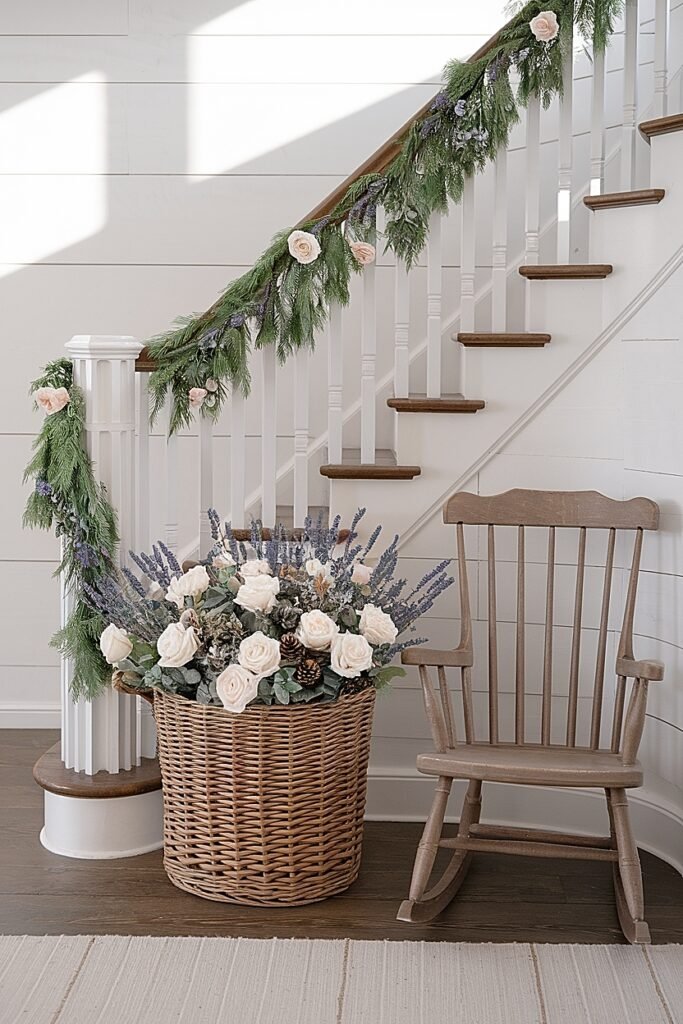
Landings are natural pauses—make them sing. I favor a compact vignette that echoes the garland rather than a new story. Scale it to foot traffic and code-clear widths.
A short olive-and-fir swag across the landing rail, a pedestal or crate stack tucked to the wall, and one footed bowl with lavender and rose heads at 6–8 inches high keeps sightlines clean.
Concentrate a single focal (bowl or lantern cluster) with one supporting swag; repeat your palette and keep profiles low. More ornament integration coming—keep reading to add sparkle the right way.
How to Incorporate Christmas Ornaments into Lavender-Rose Garlands
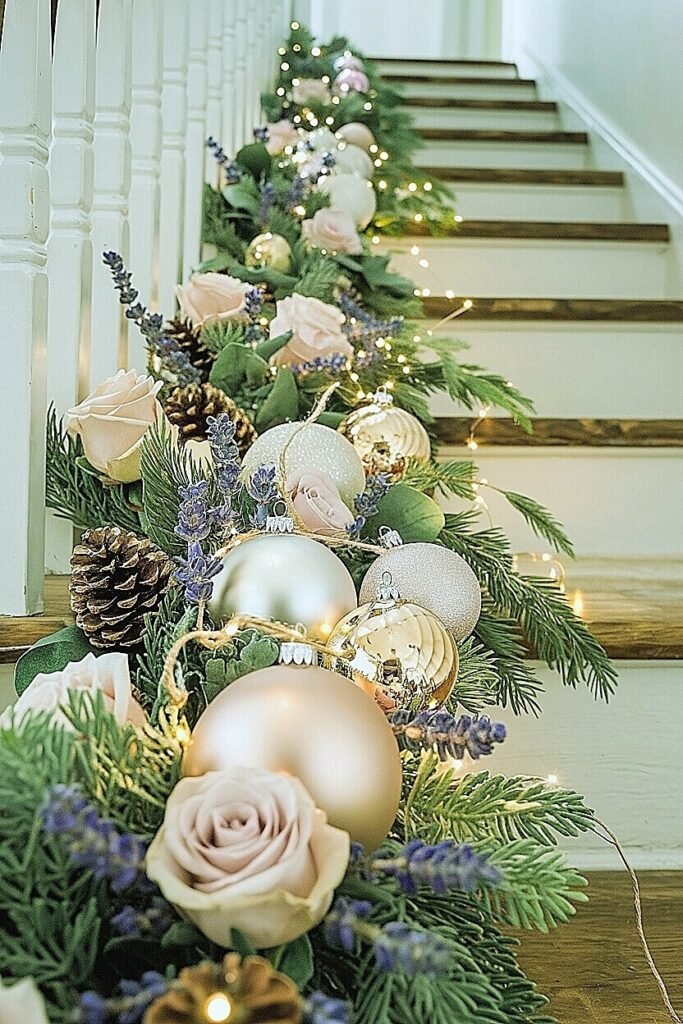
Ornaments should read like punctuation. Small, matte-heavy assortments work best on stairs. I wire each ornament to a pick—never hang by a hook from a twig.
I cluster three finishes—matte, satin, mercury—near rose anchors, add frosted drops only along the lower swag edge, and place two or three opal bulbs near micro-LEDs to diffuse hotspots.
One ornament trio per swag, drops on the lower edge only, and 70% matte to 30% metallic. More personality pieces next—keep reading for unique rustic touches that feel collected.
What Are the Most Unique Rustic Christmas Accents for Staircase Garlands?
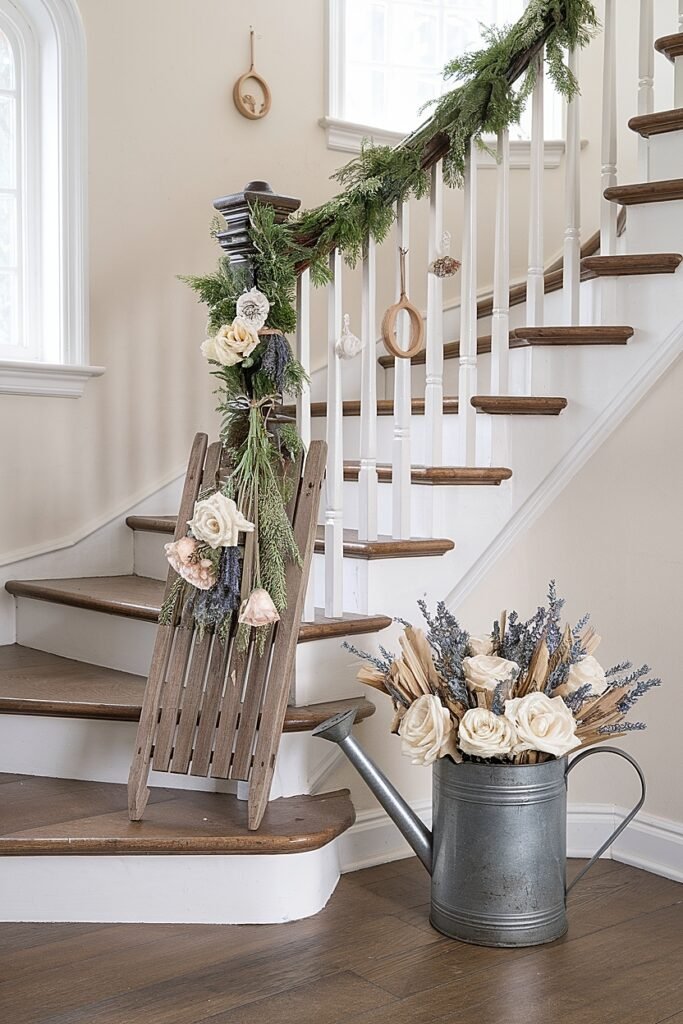
Quirk with purpose wins. I pull from farmhouse vocabulary and scale down for stairs so nothing snags sleeves.
- Mini Brass Bells on Linen: Soft jingle, old-world charm, and a pewter or brass tone to match hardware. Wire in pairs at anchors.
- Birch Bark Ribbons: Narrow strips tied into micro-knots add organic striation and photograph beautifully.
- Dried Orange + Clove Studs: One or two per turn; warm scent that plays well with lavender when used sparingly.
- Velvet-Wrapped Mini Baubles: Texture without glare; echo your main bow color in tiny repeats.
- Pressed Herb Tags: Tiny parchment tags with pressed rosemary or sage—quiet narrative, zero bulk.
- Woven Willow Links: Short, hand-twisted links tucked deep in the greens give artisan texture.
- Tiny Corked Vials of Lavender Buds: Wired discreetly near clusters; giftable on Twelfth Night.
Pick two unique accents and repeat consistently so the look feels curated, not crafty. There’s more technique sprinkled throughout—keep reading and refine as you stage.
Conclusion
A staircase garland earns its magic through structure and restraint. Build a fir-and-cedar spine, light it first, wire roses short at anchors, and let lavender write the connective script. Choose a disciplined palette, add accents that whisper, and keep ornaments matte-heavy for elegance. Ground the scene with a modest farmhouse vignette nearby, then edit without mercy. Do this, and your lavender-rose staircase won’t just look right—it will smell like calm and move like music every time someone climbs the stairs.
This website contains affiliate links, and some products are gifted by the brand to test. As an Amazon Associate, I earn from qualified purchases. Some of the content on this website was researched and created with the assistance of AI technology.
